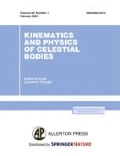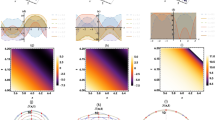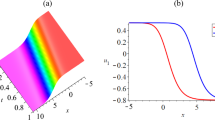Abstract—
The attenuation of the acoustic-gravitational nondivergent f-mode and inelastic γ-mode in the Earth’s upper atmosphere due to viscosity and thermal conductivity is studied. To analyze the attenuation, a system of hydrodynamic equations is used, including the modified Navier–Stokes and heat transfer equations. These modified equations take into account the contribution of the background density gradient to the transfer of energy and momentum by waves. Dispersion equations are obtained for f- and γ-modes in an isothermal dissipative atmosphere. It is shown that viscosity and thermal conductivity have little effect on the frequency of these modes under typical conditions in the thermosphere. Expressions are obtained for the damping decrements of the f- and γ-modes. It was established that the decrement of the γ-mode attenuation is almost an order of magnitude higher in the Earth’s thermosphere than the corresponding decrement of the f-mode. It is also found that the attenuation of the f-mode does not depend on the thermal conductivity but is due only to the dynamic viscosity and increases with an increase in the relative contribution of the bulk viscosity. The dissipation of the γ-mode is caused by dynamic viscosity and thermal conductivity and does not depend on the bulk viscosity. The time variation of the perturbation amplitudes for the f- and γ-modes at different heights of the thermosphere is considered. The characteristic attenuation times of the f- and γ-modes at different heights depending on the wavelength, as well as at different levels of solar activity, are calculated. The boundary heights in the thermosphere above which the f-and γ-modes cannot exist due to dissipation are determined.





Similar content being viewed by others
REFERENCES
L. D. Landau and E. M. Lifshits, Course of Theoretical Physics, Vol. 6: Fluid Mechanics (Gostekhizdat, Moscow, 1986; Pergamon, Oxford, 1987).
G. V. Lizunov and A. Yu. Leont’ev, “Height of the penetration into the ionosphere for internal atmospheric gravity waves,” Kosm. Nauka Tekhnol. 20 (4), 31–41 (2014).
A. K. Fedorenko and E. I. Kryuchkov, “Distribution of medium scale acoustic gravity waves in polar regions according to satellite measurement data,” Geomagn. Aeron. (Engl. Transl.) 51, 520–533 (2011). https://doi.org/10.1134/S0016793211040128
A. K. Fedorenko and E. I. Kryuchkov, “Wind control of the propagation of acoustic gravity waves in the polar atmosphere,” Geomagn. Aeron. (Engl. Transl.) 53, 377–388 (2013). https://doi.org/10.1134/S0016793213030055
A. K. Fedorenko and E. I. Kryuchkov, “Observed features of acoustic gravity waves in the heterosphere,” Geomagn. Aeron. (Engl. Transl.) 54, 116–123 (2014). https://doi.org/10.1134/S0016793214010022
A. K. Fedorenko, E. I. Kryuchkov, and O. K. Cheremnikh, “Attenuation of acoustic-gravity waves in an isothermal atmosphere: Consideration with the modified Navier–Stokes and heat-transfer equations,” Kinematics Phys. Celestial Bodies 36, 212–221 (2020). https://doi.org/10.3103/S0884591320050049
T. Beer, Atmospheric Waves (Wiley, New York, 1974).
O. K. Cheremnykh, A. K. Fedorenko, E. I. Kryuchkov, and Y. A. Selivanov, “Evanescent acoustic-gravity modes in the isothermal atmosphere: systematization, applications to the Earth’s and Solar atmospheres,” Ann. Geophys. 37, 405–415 (2019).
O. K. Cheremnykh, A. K. Fedorenko, Y. A. Selivanov, and S. O. Cheremnykh, “Continuous spectrum of evanescent acoustic-gravity waves in an isothermal atmosphere,” Mon. Not. R. Astron. Soc. 503, 5545–5553 (2021). https://doi.org/10.1093/mnras/stab845
M. S. Cramer, “Numerical estimates for the bulk viscosity of ideal gases,” Phys. Fluids 24, 066102 (2012). https://doi.org/10.1063/1.4729611
A. Dalgarno and F. J. Smith, “The thermal conductivity and viscosity of atomic oxygen,” Planet. Space Sci. 9, 1–2 (1962).
J. J. Dudis and C. A. Reber, “Composition effects in thermospheric gravity waves,” Geophys. Res. Lett. 3, 727–730 (1976).
A. K. Fedorenko, E. I. Kryuchkov, O. K. Cheremnykh, and Y. A. Selivanov, “Dissipation of acoustic–gravity waves in the Earth’s thermosphere,” J. Atmos. Terr. Phys. 212, 105488 (2021). https://doi.org/10.1016/j.jastp.2020.105488
S. H. Francis, “Global propagation of atmospheric gravity waves: A review,” J. Atmos. Terr. Phys. 37, 1011–1054 (1975).
C. O. Hines, “Internal gravity waves at ionospheric heights,” Can. J. Phys. 38, 1441–1481 (1960).
L. Jones Walter, “Non-divergent oscillations in the solar atmosphere,” Sol. Phys. 7, 204–209 (1969).
P. Kundu, Fluid Dynamics (Elsevier, New York, 1990).
A. Roy, S. Roy, and A. P. Misra, “Dynamical properties of acoustic-gravity waves in the atmosphere,” J. Atmos. Sol.-Terr. Phys. 186, 78–81 (2019).
S. L. Vadas and M. J. Fritts, “Thermospheric responses to gravity waves: Influences of increasing viscosity and thermal diffusivity,” J. Geophys. Res.: Atmos. 110, D15103 (2005). https://doi.org/10.1029/2004JD005574
S. L. Vadas and D. C. Nicolls, “The phases and amplitudes of gravity waves propagating and dissipating in the thermosphere: Theory,” J. Geophys. Res.: Space Phys. 117, A05322 (2012). https://doi.org/10.1029/2011JA017426
R. L. Waltercheid and J. H. Hecht, “A reexamination of evanescent acoustic-gravity waves: Special properties and aeronomical significance,” J. Geophys. Res.: Atmos. 108, 4340 (2003). https://doi.org/10.1029/2002JD002421
Funding
The work was carried out with the support of the National Research Foundation of Ukraine, project 2020.02/0015 Theoretical and Experimental Studies of Global Disturbances of Natural and Man-Made Origin in the Earth–Atmosphere–Ionosphere System and partially with the support of the Target Integrated Program of the National Academy of Sciences of Ukraine for the Scientific Space Research for 2018–2022 and The Royal Society International Exchanges Scheme 2021 “Predicting natural hazards by driven ionospheric perturbation (IES\R1\211177).
Author information
Authors and Affiliations
Corresponding author
Additional information
Translated by T. N. Sokolova
About this article
Cite this article
Cheremnykh, O.K., Fedorenko, A.K., Kryuchkov, E.I. et al. Attenuation of Evanescent Acoustic-Gravitational Modes in the Earth’s Thermosphere. Kinemat. Phys. Celest. Bodies 37, 221–229 (2021). https://doi.org/10.3103/S0884591321050044
Received:
Revised:
Accepted:
Published:
Issue Date:
DOI: https://doi.org/10.3103/S0884591321050044




